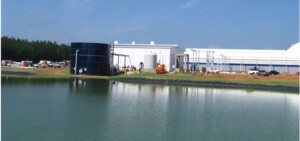Looking to maximize available resources and minimize environmental impacts, Johnson Controls built a state-of-the-art lead-acid battery recycling facility in Florence, South Carolina. CDM Smith supported this progressive environmental project by providing fast-track design-build services for the center’s stormwater and industrial wastewater treatment plant. The new facility recycles 132,000 metric tons per year—the equivalent of more than 14 million automotive batteries.
Dual treatment system: industrial wastewater and stormwater runoff

The center’s dual treatment system collects and treats its industrial process wastewater and the site’s stormwater runoff. To meet permit limits for safe discharge, the wastewater treatment system treats the recycling center’s process effluent with chemical pretreatment and pH adjustment, clarification and sand filtration. A portion of the treated effluent is reused onsite, with excess discharged to the publicly owned treatment works. The advanced system provides variable wastewater treatment using an equalization (EQ) storage tank to test wastewater influent and adjust pre-treatment chemicals for treatment optimization.
Facility addresses unique zero-discharge stormwater requirement
The state-of-the-art facility also addresses Johnson Controls’ unique zero-discharge stormwater requirement. Stormwater from factory roofs and non-roofed areas adjacent to the environmental control systems is collected and stored in a 2.3-million-gallon, high-density, polyethylene-lined impoundment. Impounded water is treated for debris and potential contamination with basket strainers and multimedia sand filtration and used as the lead smelter scrubber make-up water.
Design-build: a strategic choice for fast track implementation
Design-build was selected to deliver the facility within 10 months. A carefully coordinated construction schedule installed all major equipment directly after building slab completion and framing erection and prior to wall panel installation. Additionally, schedule coordination allowed the various building trades to complete their work in a small footprint while avoiding conflicts.
To accommodate the site’s complex hydrology, the facility’s foundation and 105,000-gallon wastewater EQ tank were built to withstand potentially extreme settlements from a seasonally high groundwater table, extensive clay deposits and perched groundwater. The impoundment’s underdrain system prevents liner floating by reclaiming seasonal high groundwater for treatment and reuse. These combined efforts—reclaiming treated process water and stormwater—ultimately reduce dependence on municipal water and regional groundwater supplies.
Awards
The project has received three awards:
- 2013 National Design-Build Award from the Design-Build Institute of America in the water/wastewater category
- 2013 Excellence in Environmental Engineering Grand Prize Award from the American Academy of Environmental Engineers and Scientists (AAEES) in the industrial waste management category
- 2013 W. Wesley Eckenfelder Industrial Waste Management Medal

